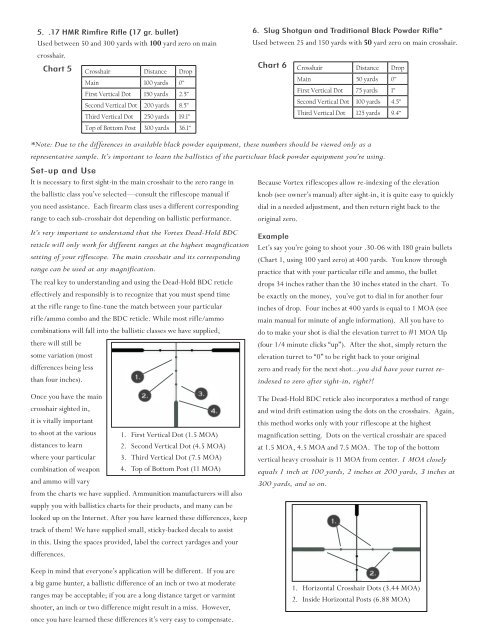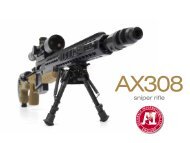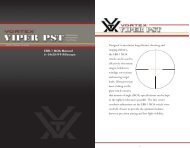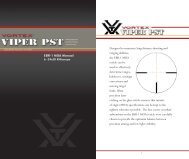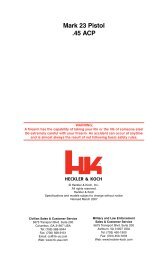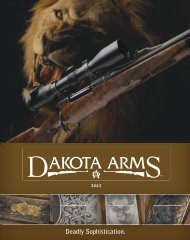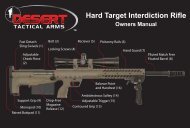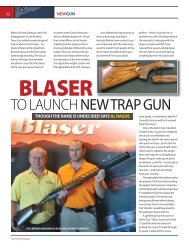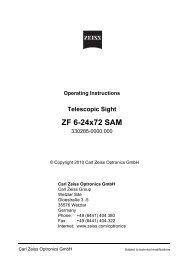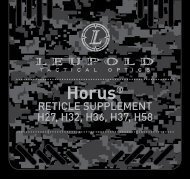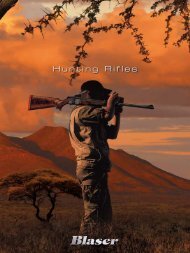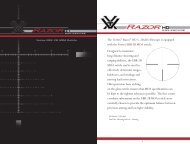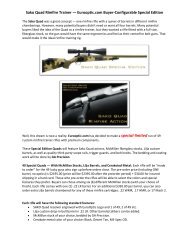Vortex Dead-Hold BDC reticle manual - EuroOptic.com
Vortex Dead-Hold BDC reticle manual - EuroOptic.com
Vortex Dead-Hold BDC reticle manual - EuroOptic.com
- No tags were found...
Create successful ePaper yourself
Turn your PDF publications into a flip-book with our unique Google optimized e-Paper software.
5. .17 HMR Rimfire Rifle (17 gr. bullet)Used between 50 and 300 yards with 100 yard zero on maincrosshair.Chart 5Chart 6Crosshair Distance DropCrosshair Distance DropMain 100 yards 0”Main 50 yards 0”First Vertical Dot 150 yards 2.5”First Vertical Dot 75 yards 1”Second Vertical Dot 200 yards 8.5”Second Vertical Dot 100 yards 4.5”Third Vertical Dot 250 yards 19.1”Third Vertical Dot 125 yards 9.4”Top of Bottom Post 300 yards 36.1”Set-up and UseIt is necessary to first sight-in the main crosshair to the zero range inthe ballistic class you’ve selected—consult the riflescope <strong>manual</strong> ifyou need assistance. Each firearm class uses a different correspondingrange to each sub-crosshair dot depending on ballistic performance.6. Slug Shotgun and Traditional Black Powder Rifle*Used between 25 and 150 yards with 50 yard zero on main crosshair.*Note: Due to the differences in available black powder equipment, these numbers should be viewed only as arepresentative sample. It’s important to learn the ballistics of the particluar black powder equipment you’re using.It’s very important to understand that the <strong>Vortex</strong> <strong>Dead</strong>-<strong>Hold</strong> <strong>BDC</strong><strong>reticle</strong> will only work for different ranges at the highest magnificationsetting of your riflescope. The main crosshair and its correspondingrange can be used at any magnification.The real key to understanding and using the <strong>Dead</strong>-<strong>Hold</strong> <strong>BDC</strong> <strong>reticle</strong>effectively and responsibly is to recognize that you must spend timeat the rifle range to fine-tune the match between your particularrifle/ammo <strong>com</strong>bo and the <strong>BDC</strong> <strong>reticle</strong>. While most rifle/ammo<strong>com</strong>binations will fall into the ballistic classes we have supplied,there will still besome variation (mostdifferences being lessthan four inches).Once you have the maincrosshair sighted in,it is vitally importantto shoot at the various 1. First Vertical Dot (1.5 MOA)distances to learn2. Second Vertical Dot (4.5 MOA)where your particular 3. Third Vertical Dot (7.5 MOA)<strong>com</strong>bination of weapon 4. Top of Bottom Post (11 MOA)and ammo will varyfrom the charts we have supplied. Ammunition manufacturers will alsosupply you with ballistics charts for their products, and many can belooked up on the Internet. After you have learned these differences, keeptrack of them! We have supplied small, sticky-backed decals to assistin this. Using the spaces provided, label the correct yardages and yourdifferences.Because <strong>Vortex</strong> riflescopes allow re-indexing of the elevationknob (see owner’s <strong>manual</strong>) after sight-in, it is quite easy to quicklydial in a needed adjustment, and then return right back to theoriginal zero.ExampleLet’s say you’re going to shoot your .30-06 with 180 grain bullets(Chart 1, using 100 yard zero) at 400 yards. You know throughpractice that with your particular rifle and ammo, the bulletdrops 34 inches rather than the 30 inches stated in the chart. Tobe exactly on the money, you’ve got to dial in for another fourinches of drop. Four inches at 400 yards is equal to 1 MOA (seemain <strong>manual</strong> for minute of angle information). All you have todo to make your shot is dial the elevation turret to #1 MOA Up(four 1/4 minute clicks “up”). After the shot, simply return theelevation turret to “0” to be right back to your originalzero and ready for the next shot...you did have your turret reindexedto zero after sight-in, right?!The <strong>Dead</strong>-<strong>Hold</strong> <strong>BDC</strong> <strong>reticle</strong> also incorporates a method of rangeand wind drift estimation using the dots on the crosshairs. Again,this method works only with your riflescope at the highestmagnification setting. Dots on the vertical crosshair are spacedat 1.5 MOA, 4.5 MOA and 7.5 MOA. The top of the bottomvertical heavy crosshair is 11 MOA from center. 1 MOA closelyequals 1 inch at 100 yards, 2 inches at 200 yards, 3 inches at300 yards, and so on.Keep in mind that everyone’s application will be different. If you area big game hunter, a ballistic difference of an inch or two at moderateranges may be acceptable; if you are a long distance target or varmintshooter, an inch or two difference might result in a miss. However,once you have learned these differences it’s very easy to <strong>com</strong>pensate.1. Horizontal Crosshair Dots (3.44 MOA)2. Inside Horizontal Posts (6.88 MOA)


